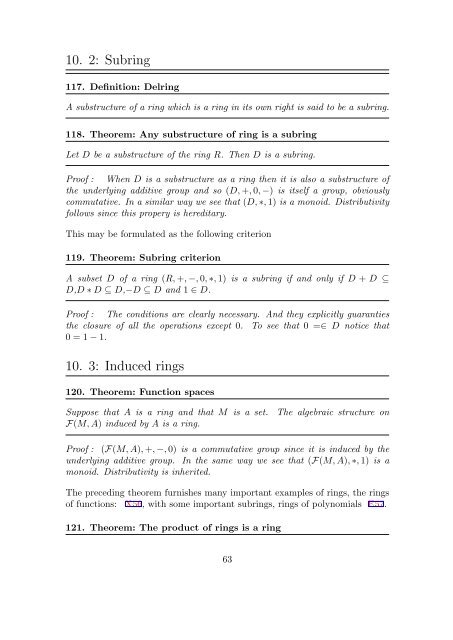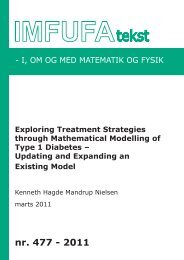ABSTRACT ALGEBRAIC STRUCTURES OPERATIONS AND ...
ABSTRACT ALGEBRAIC STRUCTURES OPERATIONS AND ...
ABSTRACT ALGEBRAIC STRUCTURES OPERATIONS AND ...
You also want an ePaper? Increase the reach of your titles
YUMPU automatically turns print PDFs into web optimized ePapers that Google loves.
10. 2: Subring<br />
117. Definition: Delring<br />
A substructure of a ring which is a ring in its own right is said to be a subring.<br />
118. Theorem: Any substructure of ring is a subring<br />
Let D be a substructure of the ring R. Then D is a subring.<br />
Proof : When D is a substructure as a ring then it is also a substructure of<br />
the underlying additive group and so (D, +, 0, −) is itself a group, obviously<br />
commutative. In a similar way we see that (D, ∗, 1) is a monoid. Distributivity<br />
follows since this propery is hereditary.<br />
This may be formulated as the following criterion<br />
119. Theorem: Subring criterion<br />
A subset D of a ring (R, +, −, 0, ∗, 1) is a subring if and only if D + D ⊆<br />
D,D ∗ D ⊆ D,−D ⊆ D and 1 ∈ D.<br />
Proof : The conditions are clearly necessary. And they explicitly guaranties<br />
the closure of all the operations except 0. To see that 0 =∈ D notice that<br />
0 = 1 − 1.<br />
10. 3: Induced rings<br />
120. Theorem: Function spaces<br />
Suppose that A is a ring and that M is a set. The algebraic structure on<br />
F(M, A) induced by A is a ring.<br />
Proof : (F(M, A), +, −, 0) is a commutative group since it is induced by the<br />
underlying additive group. In the same way we see that (F(M, A), ∗, 1) is a<br />
monoid. Distributivity is inherited.<br />
The preceding theorem furnishes many important examples of rings, the rings<br />
of functions: X56, with some important subrings, rings of polynomials E57.<br />
121. Theorem: The product of rings is a ring<br />
63
















